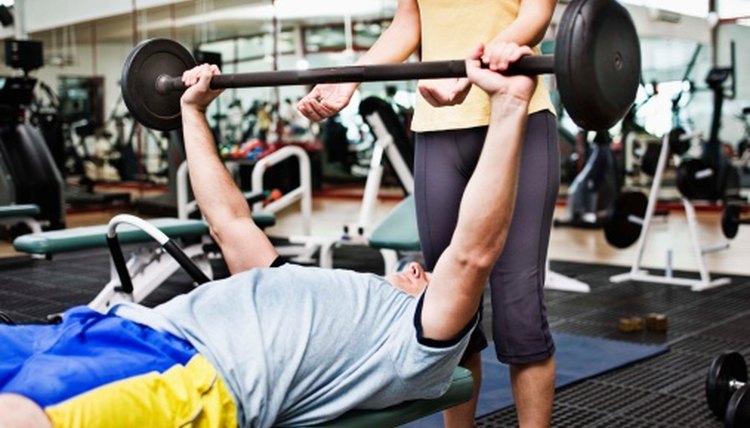Risk Analysis of Gym Equipment

Exercise should be a positive experience resulting in increased health and fitness. To ensure that dangers of injury and illness are minimized, it is important that the risks associated with exercise be strictly controlled. A risk analysis should highlight dangers, assess the potential injury and also provide solutions so that exercise equipment users are as safe as possible. Effective risk management should cover all types of exercise equipment, including cardio, free weights and resistance training machines.
Free Weight Considerations
Many free weight exercises require a large space so that you can perform the required movements without coming into contact with other users or nearby objects. Exercises such as overhead lifting and power exercises including cleans and snatches should be performed with an awareness of ceiling height. If your training area is especially cramped or busy, some exercises that utilize gross movements may be overly dangerous. Free weight exercises should be confined to a designated area to provide ample room for the performance of this type of exercise. To minimize the risk of injury while exercising, you should use a spotter when performing exercises where there is a danger of being crushed by the bar and also ensure that weights are secured in place by using collars.
Gym Equipment Position
Risk analysis should consider the position and layout of equipment. Although exercise machines have a specific floor area or foot print, machines must be positioned so that you can access them easily and safely. Treadmills, for example, should be placed so that there is sufficient space to the rear to allow users to mount and dismount in safety. Exercise equipment should be positioned so that a clear pathway is maintained around the facility at all times and that all parts of the equipment are easily accessible for maintenance purposes.
Exercise Suitability
While exercise is generally beneficial, some exercises have a higher inherent risk than others. By assessing the risk versus benefits of each exercise you can decide if an exercise is suitable. Standing on a stability ball will enhance balance, but the risk of falling may outweigh the benefits of increased balance. A safer option would be to use a BOSU balance trainer, where the risk of falling is reduced but balance is still enhanced.
Biomechanical Individuality
Exercise machines are often adjustable to fit a wide range of body shapes and height. This allows the exercise equipment to be fitted to the user. Ultimately, there are only so many adjustments that are possible, and some height and/or build extremes may not safely fit some gym equipment. Very tall, short or overweight users may find that they simply do not fit some equipment and that performing an exercise on an ill-fitting machine may be uncomfortable, possibly leading to injury. Using an ill-fitting piece of gym equipment may not result in an injury at the time but could result in problems at a later date as a result of an accumulation of stress on muscles and joints.
Equipment Maintenance and Usage
Gym equipment can break down and become dysfunctional. Nuts and bolts can work loose, cables can fray, belts can become stretched and straps can break. You can avoid many equipment failures by carrying out regular preventative maintenance and scheduled pre-emptive checks. If you use gym equipment incorrectly you may increase mechanical wear and tear and risk damaging the equipment. Gym equipment should only be used for the purpose for which it was designed; otherwise it may break during use.
References
- "ACSM's Resources for the Personal Trainer"; American College of Sports Medicine; 2009
- "Essentials of Strength Training and Conditioning"; National Strength and Conditioning Association; 2008
- "Designing Resistance Training Programs"; Steven Fleck and William Kraemer; 2003
Writer Bio
Patrick Dale is an experienced writer who has written for a plethora of international publications. A lecturer and trainer of trainers, he is a contributor to "Ultra-FIT" magazine and has been involved in fitness for more than 22 years. He authored the books "Military Fitness", "Live Long, Live Strong" and "No Gym? No Problem!" and served in the Royal Marines for five years.
